KSEEB Class 8 SSLC Biology Chapter 1 Transportation System in Plants Notes Learning Objectives
- Absorption of water and minerals (Osmosis and diffusion)
- Transpiration in plants
- Structure and function of xylem
- Structure and function of phloem
- Importance of minerals (macro and micronutrients)
Just like animals, plants also need energy from food to perform their daily activities. Green plants synthesize their own food by the process of photosynthesis. During this process, glucose and oxygen are produced. Oxygen is released into atmosphere and the glucose is transported to different parts of plants and is used to carry out different activities. The extra glucose is changed further into starch.
In everyday language ‘transport’ means ‘to carry things from one place to another’. In biology, transport is a life process in which a material absorbed (or made) in one part of the body of an organism is carried to other parts in its body.
Before we learn the transport of substances in plants, we should know the meaning of the term ‘tissue’. A tissue is a group of similar cells which work together to perform a particular function.
The arrangement of cells in a tissue depends on the function to be performed by the tissue. For example, if the function of tissue is to carry water from the roots of a plant to its leaves, then the tubular cells (tube-like cells) are arranged one over the other to form long tubes (or vessels’.
Those tissues which transport water, minerals and food to different parts of a plant, arc called vascular tissues. There are two types of vascular tissues in a plant: xylem and phloem.
- The tissue which carries water and minerals from the roots to the leaves of a plant is called xylem.
- The tissue which carries food from the leaves to other parts of the plant is called phloem.
All the parts of a plant like roots, stems, branches and leaves contain vascular tissues called xylem and phloem. The xylem and phloem tissues are a kind of tubes made of tubular cells arranged end to end. The xylem tissue is made of dead xylem cells whereas phloem tissue is made of living phloem cells arranged one over the other. Keeping these points in mind, we will now describe the transport system in plants.
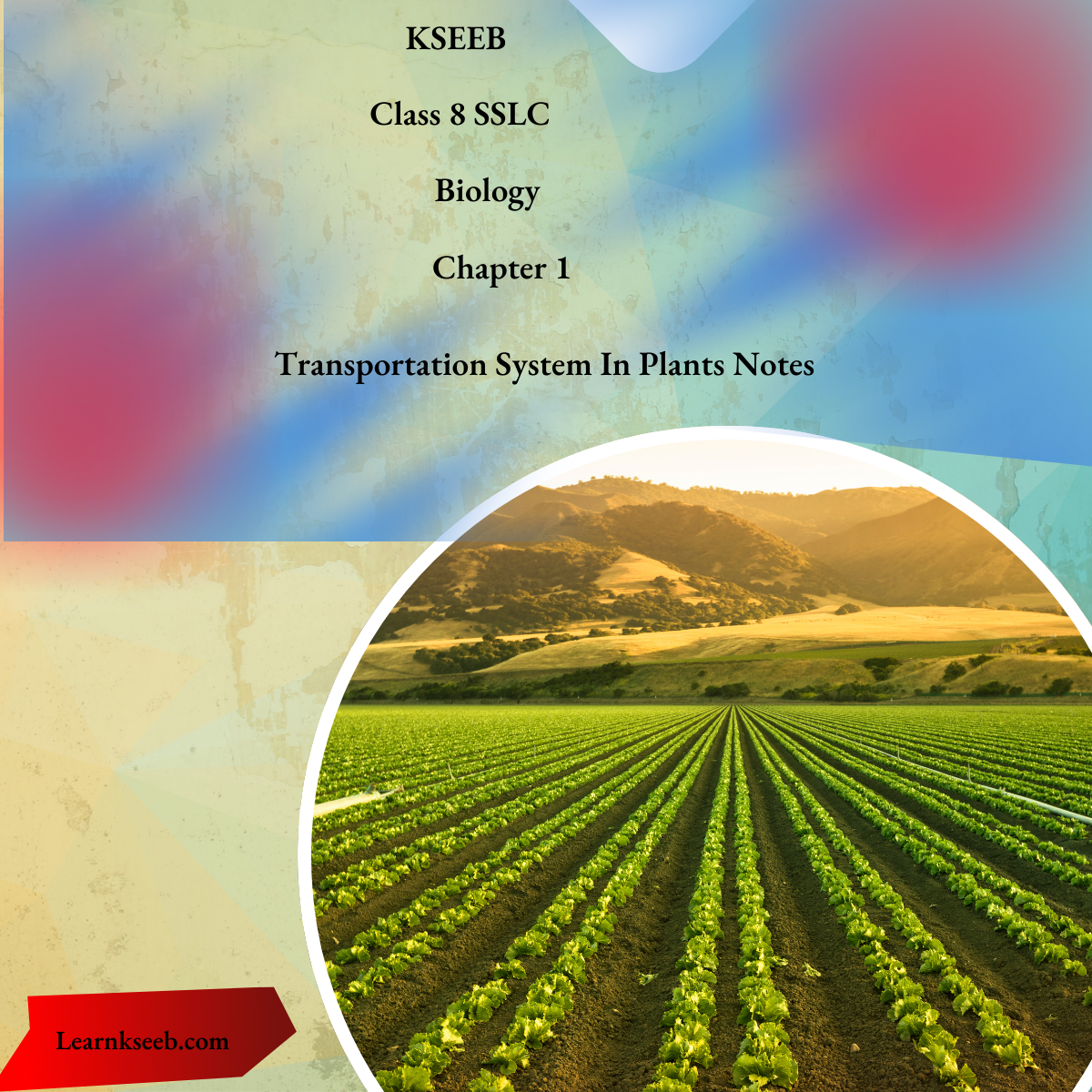
Kseeb Class 8 Biology Transportation System In Plants Notes Pdf
Absorption Of Water And Minerals
Since water and minerals are mainly available in soil, a well- developed root system is present in plants to absorb water. Roots are covered by a single-cell layer called epidermis. The epidermal cells have finger¬like tubular outgrowth known as root hairs that increase the surface area for absorption of water.
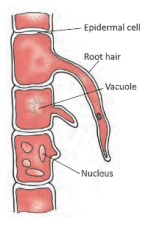
As the number of root hair increases, the surface area also increases, and the plants absorb more water and minerals.
As the plants grow, their roots branch and re-branch and get fixed in the soil. At the tips of roots, a large number of cells absorb water and nutrients from the soil. These cells have a semipermeable plasma membrane. Plasma membrane has tiny pores that allow only selected materials and water molecules to pass through it by a process known as osmosis.
Sslc Class 8 Transportation System In Plants Notes Karnataka Board
Absorption Of Water
Since the concentration of water molecules is more in the soil than in root hairs, water enters the plants body through hair by the process of osmosis. Osmosis is a process by which the molecules of solvent (water) move from a region of higher concentration to a region of lower concentration through a semi permeable membrane. The concentration of water is higher in soil, thus water moves from soil to root cells, where concentration of water is lower, through plasma membrane.

Due to osmosis, when water enters the roots, the xylem cells gets filled up and this puts pressure on the rigid outer cells of the root. This pressure causes the water to be forced up the plant against the gravity Thus, root pressure is the transverse osmotic pressure within the cells of a root system that causes sap to rise through a plant stem to the leaves.

Semi-Permeable Membrane
Activity -1
Aim: To demonstrate the process of osmosis.
Materials Required: A large-sized potato, petridish, sucrose solution Procedure:
1.Take a large-sized potato. Peel it and scoop a cavity in it. Slice its bottom to make its base flat.
2.Put the sliced potato in a petridish containing water in such a way that half of the potato is immersed in water.
3.Fill the potato cavity with 25% sucrose solution. Mark its level by inserting a pin.
4.Leave the apparatus undisturbed for some time.
Observations: The liquid in the cavity rises.
Inference: The liquid in the cavity rises because water (pure solvent) has moved through the potato walls and has accumulated inside the cavity. This happened because the concentration of water molecules in the cavity is lower due to the presence of sucrose molecules. It shows that water moves from a region of higher concentration to a region of lower concentration through a semi-permeable membrane. Potato wall acts as a semi-permeable membrane. The movement of water molecules proves that osmosis has taken place.

In the above activity, potato wall acts as a semi- permeable membrane. In case, The potato is boiled, it loses its semi-permeable nature. We will discuss about diffusion in the later part of this chapter.
As discussed earlier, root hair cells have high concentration or osmotic pressure as compared to the surrounding cells. Due to this, water diffuses from outside into the root cells. The absorption of water in the root takes place by diffusion and osmosis.
Class 8 Biology Transportation In Plants Notes Kseeb
Activity-2
Aim: To show that plants absorb water through roots.
Materials Required: A young leafy plant, a beaker and water Procedure:
1.Take some water in the beaker.
2.Put the young leafy plant in the beaker containing water.
3.Put some oil drops in the beaker to prevent evaporation.
4.Note the level of water.
5.Leave the apparatus undisturbed for some hours.
Observations: The water level reduces in the beaker.
Inference: The water level in the beaker reduces because the plant has absorbed the water from the beaker through its roots.
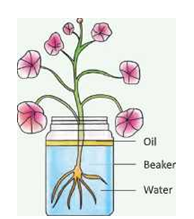
Kseeb Sslc Class 8 Biology Chapter 1 Important Questions
Absorption of Minerals
Calcium, potassium, magnesium and nitrogen are a few minerals required by the plants.
They are dissolved in water in the soil. The mineral absorption in plants takes place by means of two processes-diffusion and active transport.
Diffusion involves the movement of salt molecules from a region of higher concentration to a region of lower concentration. Diffusion takes place when the concentration of mineral molecules is higher in the soil in comparison to the root hair cells.

In case, the concentration of mineral molecules is low in the soil as compared to the root hair cells, the absorption of minerals takes place through active transport. Active transport is the movement of mineral ions from a region of lower concentration to a region of higher concentration. Generally, the concentration of minerals is low in the soil than inside the root hair cells. Thus, plants use active transport to absorb the mineral ions. Plants also require energy for this process.
Transportation In Plants
We have already studied that plants take up water and dissolved minerals from the soil through their roots and transport it to their leaves for the preparation of food. The leaves of plants prepare food by using water brought in from soil and carbon dioxide taken from air during photosynthesis. And this food has to be transported from the leaves to all other parts of the plant (which cannot make food themselves).
Plants have a transport system which serves two following purposes:
- It carries water and minerals absorbed by the roots up to the leaves.
- It also helps to transport the food made in the leaves to all other parts of the plant (including roots).

In order to carry water and dissolved minerals, as well as prepared food, a plant has a transport system inside it. The transport system in plants consists of long tubes (or vessels) called xylem and phloem. In other words, xylem and phloem transport substances in plants. The xylem and phloem carry the various substances in ‘solution form’ up and down the plant and constitute the transport system of plant.
Transportation System In Plants Class 8 Biology Summary
Structure of Xylem
The complex vascular tissue called ‘xylem’ carries water and minerals dissolved in it (sap) from the roots upwards through the stem and branches up to the leaves.
- Xylem has four different types of cells. They are tracheid; vessels or tracheae; xylem parenchyma; xylem sclerenchyma.
- Tracheids are elongated dead cells. They provide mechanical support. They play an important role in transport of water.
- Vessels or trachea form a row of cells placed end-to-end forming lube like structures called vessels. They are open from both the ends and provide mechanical support. They also help in transport of water and minerals.
- Xylem parenchyma are the only living cells present in the xylem tissue.
- They help in conduction of water and minerals. These parenchyma cells also store reserve food in the form of starch.
- Xylem sclerenchyma are narrow and tapering cells and help provide mechanical strength to the tissue.
- Except for parenchyma cells, rest of the xylem elements are bounded by thick lignified walls and are dead.
Functions
The xylem tissue forms a continuous network of vessels (or channels) that connect the roots to the leaves through the stem and branches, and thus transports water (and dissolved minerals) to the leaves of the entire plant. The water rises from the roots upwards towards branches and leaves in a plant. In a plant, water evaporates continuously from the leaves through the pores called stomata’. This process is called transpiration. It generates a ‘suction force’ which pulls up water absorbed by the roots from the soil to reach the leaves (through the stem and branches). The water and dissolved minerals (also called sap) move in an upward direction against the gravity to reach the leaves of the plant. This upward movement of sap (from the root to the top of a tree) is called ascent of sap. It is aided by transpiration and root pressure.
Structure of Phloem
The complex vascular tissue called ‘phloem’ carries the food from the leaves to all other parts of the plant (including roots). Phloem has four different types of cells. They are sieve lubes; companion cells; phloem parenchyma; phloem fibres.
- Sieve tubes are long tube-like structures arranged longitudinally and are found in association with companion cells. The end walls are perforated just like a sieve to form sieve plates.
- Companion cells are specialized parenchymatous cells. They form association with sieve tubes and help them in the conduction of food material.
- Phloem parenchyma cells are cylindrical, elongated with tapering ends. They have cellulose in their cell wall. These cells store food and other substances.
- Phloem fibres are made of sclerenchymatous cells. They are elongated with pointed apices and have thickened cell walls.
- All the phloem cells are living except the phloem fibres.
Functions
The phloem tissue forms a network of vessels (or channels) that connect the leaves to all the parts of the plant including roots, and thus transports food to the entire plant. Please note that the food which is made in the leaves during photosynthesis consists of glucose (sugar) and it is transported within the plant in the form ol solution (called glucose solution’). The force needed to push the dissolved food (glucose solution) in phloem vessels is generated by the living phloem cells present in the phloem tissue of the plant.
Karnataka Sslc Biology Class 8 Transportation Notes In English
How Water Reaches From Soil to Xylem Vessels in Roots
We have just studied that water (and minerals dissolved in it) are carried from the roots of a plant to the leaves by the xylem vessels. Now, the xylem vessel of a root is in the centre of the root and it is surrounded by a large number of other cells of the root. This means that the xylem vessel of a root is not in direct contact with the water present in the soil particles. So, an important question now arises: How does water from the soil reach the xylem vessel which is in the centre of the root of a plant? The answer to this question is that: For very short distances, water can move from cell to cell.
From the above discussion, we conclude that water (containing dissolved minerals) from the soil enters a plant through its root hair. From root hair, water moves from cell to cell in the root till it reaches xylem vessel in the centre of the root. From the xylem vessel in root, water moves upward to the xylem vessels in stem, branches and leaves.
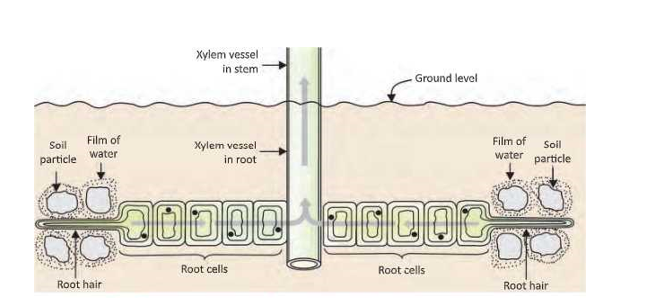
Activity -3
Aim to show that only roots absorb water for plants
Materials required: Test tubes, water, dyes, cork, oil, balsam plants
Procedure: Take three test tubes and mark them as 1. 2 and 3,. In test tubes 1 and 2 fill water up to three quarters. Fill test tube 3, less than a quarter with water.
In case of test tube 1, fix a cork at its mouth and leave it. Now, take two small-sized balsam plants having their roots intact. Wash their roots properly to remove soil and other particles. Now, in case of test tube 2, place a balsam plant so as its roots remain dipped in water. In case of test tube 3, insert the plant so that its roots do not touch water and are placed well above it.
In test tube 2 add a few drops of caramine dye (pinkl. Pour some drops of oil in test tube 2 which will float on the surface of water and prevent evaporation. Now*, mark the water level in all the three test tubes and leave them undisturbed for 24 hours.
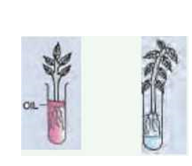
Observation:
Test Tube 1: After 24 hours, it was observed that water level in test tube 1 remains unchanged. This shows there was no loss of water due to evaporation.
Test Tube 2: Water level falls below the marked level. The pink colour of dye can be seen in the veins of leaves. As water cannot evaporate due to presence of oil, so the lost water is taken up by plants through roots. Test Tube 3: The water level has gone down but the eaves of the plants have shriveled. Leaves lost water due to transpiration but that water wasn’t replenished as roots were not in contact with water. The water evaporated from the surface.
This experiment shows that a plant absorbs water through its roots.
Kseeb Class 8 Biology Transportation System Solved Questions
Activity*4
Aim: To study the transportation of water through xylem tissues.
Materials Required: A soft flowering twig with roots intact (with white flowers of Petunia, Balsam or Vinca), pink ink, beaker, water, microscope
Procedure
Pour some water in the beaker. Add a few drops of pink ink to the water.
Put the twig in the beaker and leave it undisturbed for an hour.
Cut thin slices of stem on a glass slide.
Keep the sliced stem on the glass slide.
Put a few drops of water on the slide and observe the stem under Xylem transports water microscope.in plants

Observations: The xylem tissue of the vascular bundle gets stained pink
Inference: Xylem tissue helps in conduction of water.
Class 8 Sslc Biology Chapter 1 Transportation System Study Material
Activity-5
Aim: To demonstrate that food is transported through the phloem.
Materials Required: A plant pot, water, a healthy plant with thick stem
Procedure:
- Take a healthy plant with thick stem.
- Cut a ring around the stem of the plant deep enough to penetrate the phloem and cambium but not the xylem.
- Fix the plant in the plant pot. Water the plant regularly.
- Leave the apparatus for a few days.
Observations: The part of the stem above the ring has grown in diameter while the growth of the stem below the ring has stopped.
Inference: The stem above the ring shows the growth in diameter because of the accumulation of food
manufactured in the leaves. There is no growth in the lower portion because the removal of phloem blocked the downward movement of food.
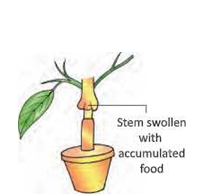
Transpiration
Loss of water from the plant in the form of water vapour is known as transpiration. In plants, transpiration takes place from different regions— stomatal, cuticular and lenticular.
- Stomatal transpiration: Evaporation of water from the leaves talcing place through the stomata is called stomatal transpiration.There are more stomata present on the undersurface of a dicot leaf. Therefore, more transpiration takes place from the lower surface of leaf.
- Cuticular transpiration: When the evaporation of water takes place direedy from the surface of the leaves and herbaceous stems, it is known as cuticular transpiration.
- Lenticular and bark transpiration: When evaporation of water takes place through the lenticels and the bark, it is called lenticular and bark transpiration.
Transpiration is directly proportional to absorption. Higher the rate of transpiration, more will be the rate of absorption. Rather, transpiration plays an important role in the absorption of water.
The loss of water from the leaves through transpiration creates a suction pressure in the xylem vessels. The suction pressure pulls up water from the roots dirough the stems to the leaves. This is called transpiration pull.
It causes a reduction in the volume of water in the roots. That in turn causes the movement of water from the surrounding soil to the root hair. The root hairs absorb the water by the process of osmosis. Thus, the cycle continues.
When the rate of transpiration is greater than the rate of absorption of water from the root hair, the leaves, stems and flowers of the plant begin to droop. This is called wilting.
Factors Influencing Transpiration
Some of the factors which influence the rate of transpiration are discussed here:
Temperature: The rate of transpiration increases with increase in temperature. High temperature favours evaporation of water from the leaves.
Light: During day time, stomata remains open hence most of the transpiration lakes place during the day. At night, the stomata remain closed, so very little amount of water is lost by cuticular or lenticular transpiration.
Humidity: The amount of water content of air is known as humidity. This humidity is expressed as vapour pressure. With increase in humidity, the rate of transpiration decreases. The rate of transpiration increases, if the hum idity is low, that is, vapour pressure in the surrounding atmosphere is low.
Wind speed: The rate of transpiration increases in moving air (or wind). This is because moving air carries away water vapour from leaves as fast as it comes out of stomata. And when the rate of transpiration increases, then the rate of absorption of water through the roots also increases. Thus, water absorption through roots can be increased by keeping a potted plant under the fan.
Kseeb Biology Class 8 Transportation System In Plants Mcqs
Importance of Transpiration
The process of transpiration (evaporation of water from leaves) serves a very useful function in the plants.
- It generates a ‘suction force’ in xylem which can pull water from the roots up to great height in the tall trees.
- When cells absorb water, they remain turgid. This helps in maintaining the shape and structure of the plant body.
- Another function of transpiration is that it cools the plant in hot weather. This happens due to cooling caused by evaporation.
- The main function of stomata is to allow carbon dioxide to enter into the leaves for photosynthesis. It simultaneously functions to prevent excessive water loss.
Transpiration can be demonstrated by the following methods:
Method 1:
Take a small-potted plant and cover the soil surface In the pot with the polythene sheet.
Now cover the potted plant with a big glass bell jar. Keep the set-up under the sun and leave it undisturbed for few hours. Moisture droplets appear on the inner walls of the glass bell jar. The moisture in the bell jar comes from transpiration.
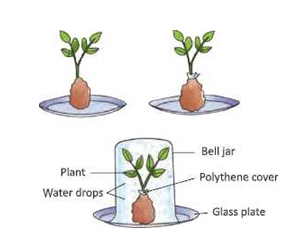
Method 2:
This method is used to compare the rate of transpiration between the two surfaces of the same leaf suggesting that more stomata are present in the lower surface of the leaf.
Take two strips of filter paper soaked in 2 % solution of cobalt chloride and leave them to be perfectly dried under sunlight. Cobalt chloride paper is blue in colour when it is dry, and becomes pink when it absorbs moisture. Due to this characteristic feature, it acts as a chemical indicator in this experiment.
A piece of dry blue cobalt chloride paper is kept on a leaf. It is covered by a glass slide with clips. The colour of cobalt chloride changing from blue to pink shows transpiration. The time taken for this change determines the rate of transpiration.
Importance Of Minerals
Minerals are very important for the healthy growth of plants. These are absorbed through the roots in the dissolved form along with water. The minerals (nutrient elements) required by the plants are divided into two categories— macronutrients and micronutrients. Macronutrients are the mineral elements that are required in large quantities by the plants. They play an important role in balanced crop nutrition. They include nitrogen (N), phosphorus (P), potassium (K), calcium (Ca), sulphur (S) and so on.
Micronutrients are required in extremely small quantities by the plants. They include iron (Fe), manganese (Mn), zinc (Zn) and many more.
Class 8 Biology Xylem And Phloem Notes Karnataka Board
Chapter 1 Transportation System In Plants Keywords
Osmosis: The diffusion of water {or solvent) across semi permeable membrane from a region of its high concentration to a region of its lower concentration
Diffusion: The movement of fluid from the region o* higher concentration to the region of lower concentration
Active transport: The transport of substances across the cell membrane against concentration gradient with the input of energy
Sap: Water and dissolved minerals that are conducted by a plant
Root pressure: The pressure that develops in xylem vessels as a result of metabolic activity of roots Transpiration: The process that causes loss of water in the form of water vapour through the aerial parts of a plant
KSEEB Class 8 SSLC Biology Chapter 1 Transportation System In Plants Summary
- In biology, transport is a life process in which a rraterial absorbed (or made) in one part of the body of an organism is carried to other parts in its body.
- Those tissues which transport water, minerals and food to different parts of a plant, are called vascular tissues. There are two types of vascular Tissues in a plant: xylem and phloem.
- Since water is mainly available in soil, a well-developed root system is present in plants to absorb water.
- Osmosis is a process by which the molecules of solvent (water) move from a region of higher concentration to a region of lower concentration through a semi permeable membrane.
- Root pressure is the transverse osmotic pressure within the cells of a root system that causes sap to rise through a plant stem to the leaves.
- The absorption of water in the root takes place by diffusion and osmosis.
- The mineral absorption in plants takes place by means of two processes-diffusion and active transport.
- The complex vascular tissue called ‘xylem’ carries water and minerals dissolved in it (sap) from the roots upwards through the stern and branches up to the leaves. This upward movement of sap (from the root to the top of a tree) is called ascent of sap.
- The phloem tissue forms a network of vessels (or channels) that connect the leaves to all the parts of the plant including roots, and thus transports focd to the entire plant.
- Loss of water from the plant in the form of water vapour is known as transpiration. In plants, transpiration takes place from different regions— lenticular, cuticular and stomatal.
- Minerals are very important for the healthy growth of plants. These are absorbed through the roots in the dissolved form along with water. The mine’als (nutrient elements) required by the plants are divided into two categories— macronutrients and micronutrients.
Part A – Our PASTS – III (History)
- Chapter 1 How, When and Where
- Chapter 2 From Trade to Territory The Company Establishes Power
- Chapter 3 Ruling the Countryside
- Chapter 4 Tribals Dikus and the Vision of a Golden Age
- chapter 5 When People Rebel 1857 And After
- Chapter 6 Colonialism and the City: The Story of an Imperial Capital
- Chapter 7 Weavers, Iron Smelters and Factory Owners
- Chapter 8 Civilising the “Native” Educating the Nation
- Chapter 9 Women, Caste and Reform
- Chapter 10 The Changing World of Visual Arts
- Chapter 11 The Making of the National Movement 1870s -1947
- Chapter 12 India After Independence
Part B – Resources and Development (Geography)
- Chapter 1 Resources
- Chapter 2 Land,Soil, Water, Natural Vegetation and A wildlife Resources
- Chapter 3 Mineral and Power Resources
- Chapter 4 Agriculture
- Chapter 5 Industries
- Chapter 6 Human Resources
Part C: Social and Political Life -III (Civics)
- Chapter 1 The Indian Constitution
- Chapter 2 Understanding Secularism
- Chapter 3 Why Do We Need a Parliament ?
- Chapter 4 Understanding Laws
- Chapter 5 Judiciary
- Chapter 6 Understanding Our Criminal Justice System
- Chapter 7 Understanding Marignalisation
- Chapter 8 Confronting Marginalisation
- Chapter 9 Public Facilities
- Chapter 10 Law and Social Justice
